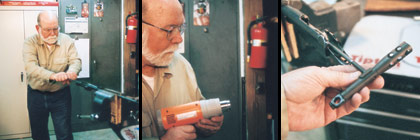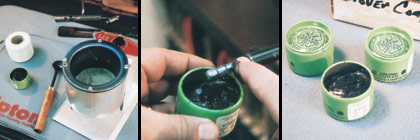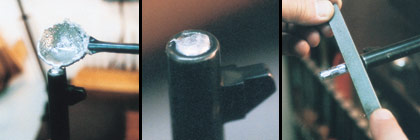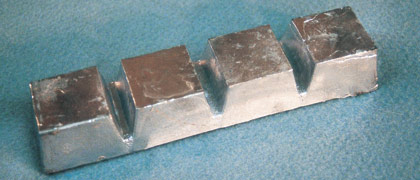September 23, 2010
By Reid Coffield
 (left) This French Berthier Model 1916/1927 probably saw use during World War I and has a less than perfect bore. Its bore can be improved by lapping using a lead slug.
(center) Coffield uses a hot air gun to heat the barrel prior to casting the lap in the bore.
Advertisement
(right) Make sure you have a very sturdy rod for the lap. Coffield uses an old surplus M14 steel cleaning rod. |
If someone suggested you rub the inside of your rifle barrel with sand, would you do it? That's a pretty stupid question, right? Of course you wouldn't.
From day one, we're taught to treat the bore with TLC. We're admonished by every gun expert, self-proclaimed and otherwise, to be extra careful and never allow the slightest amount of wear or smallest bit of abrasive to make even the tiniest scratch inside the barrel.The rifle bore is one of those mysterious and sacred areas we can only approach with care and by following the specific instructions of experts. After all, if we do anything wrong, we'll ruin the barrel, or so we're told. But like so much popular wisdom, that's not always true.
Advertisement
Over the years, I've developed an interest in older military bolt-action rifles. One of the things I've discovered is if I can afford the rifle, it's probably not in the best shape. In fact, it's pretty safe to say it'll be darn rough! That's okay with me; I'd much rather have a rifle that saw use than a mint-condition example that was never issued.
The problem with these old rifles is compounded by the fact that most military ammo used up through the end of World War II had corrosive primers. If you're standing in mud with somebody shooting at you, you seldom have the time or inclination to go through all the machinations necessary to thoroughly clean your rifle after firing corrosive ammo. Consequently, many--if not most--of these old warhorses have pretty rough bores with pitting ranging from light to "oh my gosh."
 (left) A simple Lee melting pot is ideal for preparing the lead.
(center) A small, coarse, flat file is used to cut grooves around the lap (top), and the abrasive paste is applied sparingly to the lap
(right) Clover lapping compound is a grease-based silicone carbide abrasive available at many auto parts stores. |
If I just wanted to hang these old rifles on the wall, the bore condition wouldn't matter all that much. But for me, part of the romance of these rifles is taking them to the range and firing them. It's one thing to read about 'em, but I want to know what it feels like, how it sounds, and even its aroma after firing.
The problems with a rough bore are that it hurts accuracy and leads to excessive fouling. The pits actually rip metal from the bullet as it passes down the bore. If nothing else, this roughness makes cleaning a real chore.
One way to deal with a bad barrel is to smooth the bore and remove, or at least lessen, the effects of the pitting. That's were the sand comes in.
The only way to smooth the bore is to go over it with an abrasive such as silicone carbide, which is basically like super-fine sand. There are two ways of getting the abrasive into the bore. The quickest is to coat a bullet with abrasive and fire it through the bore. This is called fire lapping and has become quite popular in the last few years. The other method, which I prefer, is a more traditional lapping technique using a lead slug, abrasive, and a sturdy rod. Now keep in mind that I'm talking about rifles with barrels just one step away from being used as tomato stakes. I'm not talking about super-nice commercial barrels or wringing sub-minute-of-angle accuracy from them. If you've got a barrel like that, go see a good gunsmith. I'm dealing with ratty old barrels, and any improvement I make is a net gain.
 (left) The molten lead is carefully poured into the muzzle end of the barrel.
(center) Note the lead "button" that has formed as the lead spreads out into the crown of the muzzle. The flange of the "button" must be removed before the lap can be pulled into the bore.
(right) A small, coarse, flat file is used to cut grooves around the lap (top), and the abrasive paste is applied sparingly to the lap (bottom). |
Traditional lead lapping of a barrel begins by disassembling the rifle and thoroughly cleaning the bore. Spend as much time as necessary to remove any carbon or bullet-jacket fouling. After an extensive cleaning, you may be surprised to find the bore actually looks worse and even rougher! In cleaning, you may have emptied the pits of built-up fouling, and the bore appears to be worse. That has happened to me on a number of occasions.
With the bore cleaned, take a sturdy cleaning rod with a jag or metal patch loop and insert it from the breech end until the jag or loop and a half-inch or so of the rod projects from the muzzle. Take a bit of regular cotton twine and wrap it around the rod just ahead of the muzzle. Use enough twine to form a good seal around the rod. This will prevent the liquid lead we use to form the lap from flowing past the twine seal and into the barrel.
Use a hot air gun or propane torch to heat the barrel from the muzzle back about 3 or 4 inches or so. The barrel doesn't have to be super hot, just very warm to the touch. A heated barrel will minimize voids or imperfections in the lead casting. It's also a good idea to heat the jag or loop.
 Cotton twine is wrapped around the rod to seal the bore under the lead lap. |
When you have it properly heated, pull the rod back into the barrel until the top of the loop is about one inch below the muzzle. Pour in melted lead until the lead is even with the muzzle. Needless to say, be darn careful and wear gloves and protective clothing. Hot, molten lead can cause severe burns. That's also another good reason to have the barreled action out of the stock and supported in a padded vise.
By the way, I use almost pure lead because it's softer than lead with a high tin or antimony content. The p
ure-lead lap moves through the bore much easier than a hard lead-alloy lap.
Allow a few minutes for the lead lap to cool and solidify. Next, push the rod from the breech so the lap extends forward out of the muzzle about 3 inches. I use a 6-inch coarse flat file to remove any lead extending out further than the diameter of the bore. More often than not there's a "button" of lead that extends into the crown. If you don't file it away, you'll never be able to pull the lap through the barrel.
Use a small file to cut some grooves around the lap. This can be one long spiral groove or several separate circular grooves; it really doesn't matter. The important thing is that you have these grooves to help carry some of the lapping abrasive.
 Coffield prefers almost pure lead for barrel lapping. |
While you could use almost any abrasive, with these old barrels I have found that Clover silicone carbide grease-based abrasive--generally available in automotive parts stores--works just fine. I have a shop sampler kit with 2-ounce tins in grits from 120 up to 800. I seldom need to use finer than the 240 grit.
I apply the grit by simply putting a bit on my finger and rubbing it over the lap. It doesn't take much. In fact, if you use too much, it'll make pulling the lap through the bore almost impossible.
With the lap loaded with abrasive, the cleaning rod is pulled back through the bore. By the way, I use an old cleaning rod designed for use with the M14 rifle. Be very careful that you don't pull the rod so far that the lap disengages from the rifling. If you accidentally pull the lap out of the barrel, just melt the lap off the rod and start over. A piece of tape wrapped around the rod about 4 inches below the lap is a good, simple means of keeping track of the location of the lap as it nears the chamber.
Pulling the lap through the barrel can be very tough initially, especially if the bore is rough. As you work the lap back and forth in the barrel, it will begin to move more easily. After about a dozen strokes or so, you'll feel a noticeable difference. This is due to wear on the lap and the abrasive smoothing the bore.
As the lap wears, you'll want to melt off the old one and recast a new, tight lap. I use my hot air gun to do this, but you can also use a propane torch. I generally replace the lap three or four times while using the same grit of abrasive. Once I have completed a series of three or four laps with the initial 120-grit abrasive, I clean the barrel and check my work.
I generally notice a significant difference in how easily a cleaning patch will move through the bore. There is also a visual difference in the brightness of the bore. It just looks better!
Depending upon the condition of the bore, I repeat this cycle of steps with 180- and then 240-grit abrasive. Each time, the bore should look and feel smoother. Just how far you should go with higher grit abrasives or how long you should lap the barrel is entirely subjective. Do it until you're satisfied. If you later decide you want the bore smoother, just pull out the lapping supplies and go for it.
Lapping old military rifles will not make a rusty tube into a prize-winning match barrel, but it can help to make the rifle more enjoyable to shoot. It's just amazing what you can do with a little bit of sand.
Until next time, good luck and good gunsmithing.
